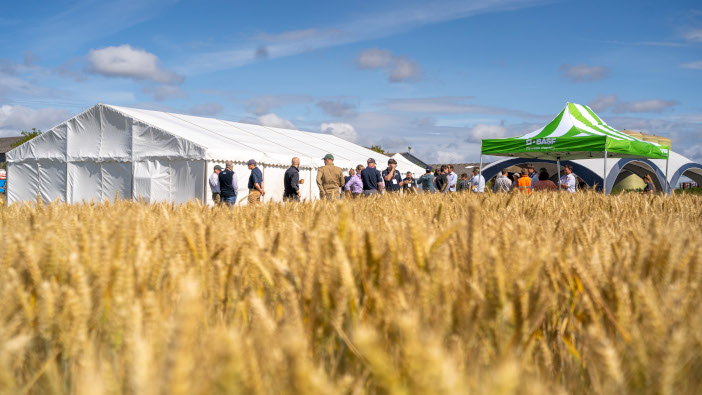Project Fortress, a five-year trial exploring strategies to increase resilience to climate change, has seen its first set of interim results, which were revealed at The Grange, in Northamptonshire.
The farm, which is run by Andrew and William Pitts, has a 12.5-hectare field of Hanslope clay which has been divided into five plots, with different approaches being implemented and analysed.
“Each strategy aims to improve soil health and increase carbon storage, keeping land in production while ensuring there’s a home for wildlife and biodiversity,” explained William Pitts.
Alongside broadacre crops, the plots include three and four-year herbal leys with grazing sheep, and ‘supercharger’ cover crops. The plots are interspersed with agrofloristy – 2m of undisturbed grass between two 3m meadow flower strips – and have been topped and tailed by headlands which are out of production.
Both Andrew and William have kept a close eye on productivity and profit, while a team of experts are analysing the effects on soil and biodiversity.
“Being sustainable within the context of agriculture means having a viable business – building and maintaining an adequate income stream – as well as maintaining everything that co-exists around us,” said William.
“It’s what Project Fortress is all about – talking about ‘sustainability’ is no longer enough,” added BASF agricultural sustainability manager, Mike Green. “Climate change is accelerating and our adaptation needs to take us ahead of it.”
Interim results
In just two years, the project has reported increased organic matter in the topsoil, where herbal leys and sheep grazing has been utilised.
“When I first looked at this field, it was clear that it was degraded,” said independent soil consultant Jenni Dungait. “The field’s topography and underlying geology and soil type make it prone to erosion and compaction.”
Her initial analysis showed that the topsoil had 6.5% organic matter but that the subsoil was very compacted and had very little organic matter.
“To our surprise, some of the deep-rooting plants in both the herbal leys and cover crops have managed to penetrate the compacted layer,” she said. “Given a second season, the chicory grew to over 5ft tall and its taproot just about broke through. However, even taproots would take years to achieve what a sub-soiler can do in a single pass.
“The thick taproot of the sweet clover in the ‘supercharger‘ cover crops also penetrated the tightly packed layer. Deep roots like this are really important – with carbon in its biomass and in the exudates it’ll be releasing, it’s getting carbon deep into the soil. That root will also keep the soil structure open, allowing air and water to penetrate.”
The Game and Wildlife Conservation Trust (GWCT) has been monitoring insects at the farm since 2017, and has assessed the impacts of Project Fortress with pitfall traps and an insect vacuum.
“The move from ploughing to direct drilling on this farm has had a significant impact on insect populations,” explained GWCT research ecologist, Lucy Capstick. “We’ve seen beneficial insect numbers increase where the soil structure has not been disturbed and there’s an increase in organic matter on the soil surface. Interestingly, we’ve also seen fewer pest species.”
“With the areas designated to biodiversity getting more established, this May we recorded 2.5 times more insects than last within the confines of Project Fortress.”
According to BASF, one of the biggest impacts of the project has been its reach. “With policymakers, regulators, farmers and other stakeholders coming to see the farm and the trial, it’s been a catalyst for conversation and inspiration for action,” said Mr Green.
“We had been working on issues that come under the umbrella of ‘sustainability’ long before Andrew met the team at BASF. But nobody listens to two farmers from Northamptonshire. BASF has given us a platform on which we can share our journey, exchange ideas with other farmers, and discuss the challenges and opportunities with experts, and those with influence. It’s been both a flattering and humbling experience,” added William.
For more information go to www.basf.com


